Without a doubt, Tokyo is one of my favourite cities I’ve ever visited. The unique blend of ultra-modern and traditional, the exhilarating experiences and of course, the incredible food are just some of the reasons I keep coming back to Tokyo again and again.
After my recent fifth visit to Tokyo, I can truly attest that there is no shortage of remarkable things to do, see and eat in Tokyo. Packing it all into a Tokyo 1 week itinerary is still a challenge, as each visit I find something new and fun to do every time!
Whether it’s your first time in Tokyo or a return visit, this comprehensive 7 days itinerary in Tokyo offers a perfect blend of iconic sights, lesser-known gems and amazing food experiences to ensure a memorable one week in Tokyo.
Quick Overview: Itinerary for Tokyo 7 Days
Tokyo is a sprawling metropolis that covers over 2,000 square kilometres. This itinerary has been designed to cover specific sections of the city and groups attractions on each day to reduce travel time and backtracking.
Here’s a summary breakdown of this Tokyo Itinerary:
- Day 1: Harajuku and Shibuya
- Day 2: Gotokuji Temple, Shimokitazawa and Shinjuku
- Day 3: Asakusa & Akihabara
- Day 4: Tsukiji Market, TeamLab Planets & Ginza
- Day 5: Hie Shrine, Imperial Palace, Tokyo Station & Ikebukuro
- Day 6: Disneyland or DisneySea
- Day 7: Day Trip to Mount Fuji
Useful Resources & Tips for First Timers
Before getting into the details of this Tokyo 7 days itinerary, here are a few quick tips and useful things to know for first-timers in Tokyo.
- Cash: Japan is a very cash-reliant society. On my most recent trip in April 2023, we were pleased to see that many more places accept cards (most likely a result of COVID-19 accelerating change for businesses). However, there are still many small bars, restaurants and even shops that might only take cash. We use the 7/11 ATMs to withdraw cash, as there is no international ATM fee and they accept most foreign cards. Plus, they are super accessible as there are 7/11’s everywhere!
- Suica: Make sure to grab a Suica (prepaid transport card) for use on the subways, trains and buses across Tokyo. It saves you so much time not having to purchase paper tickets as you’ll be relying on the subway system a lot! (more of this soon).
Note: Due to a chip shortage, physical cards are no longer being issued. You have two options for alternatives. Firstly, Apple users can easily add a free Suica to Apple iPhones (unfortunately this doesn’t work for foreign Android devices just yet). Here are the instructions for doing this for Apple users.
Tourists can still purchase the Welcome Suica card upon arrival at either of Tokyo’s airports. More information on Welcome Suica here.
Alternatively, you can purchase an unlimited-use metro card (more information on this below in the Getting Around Tokyo section).
- eSims: I recommend getting phone data while in Japan as you will be relying on Google Maps a LOT! Pocket wifi rental used to be a popular option for getting phone data in Japan.
I’ve tried pocket wifi, purchasing a tourist prepaid sim that you collect at the airport and on my most recent trip, an eSim that I set up at home before I even leave.
Of the three options, using an eSim is my preferred option for convenience and was very easy to set up on my iPhone. Check out eSIM plans & pricing for Japan here.
- Airports: Tokyo has two international airports, Haneda and Narita. If you have a choice, try to fly into Haneda as it is a lot closer to downtown Tokyo. However, the majority of flights do fly into Narita, which is still very accessible to get to/from with public transport – it just takes longer and is more expensive.
- Queues: Queuing is very much a part of culture in Japan – you know a restaurant is good when there is a queue! Especially for ramen restaurants, the queues move quickly so don’t despair if you see a giant line.
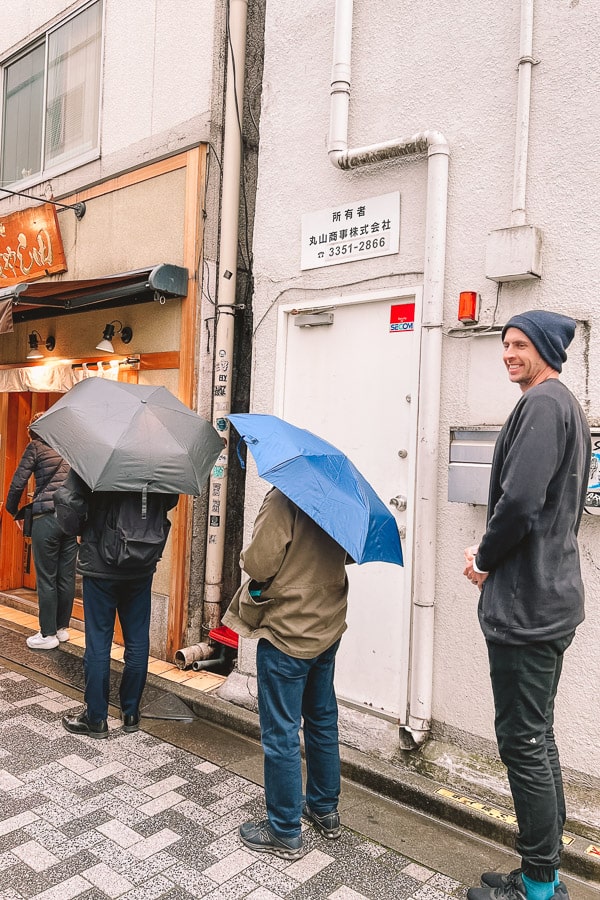
- Convenience Stores: one of my favourite things about Japanese culture is the convenience stores (konbini). You’ll see a 7/11, Lawsons or Family Mart on just above every corner, and these well-stocked shops sell fantastic ready-to-eat meals.
We’ve had many onigiri (rice triangle sandwiches) for breakfast from the konbini, as well as great takeaway dinners on those days when we are just too exhausted to go out after exploring the city all day. The quality and range are excellent, and trying random new Japanese snacks from the local konbini is a personal tradition of mine!
- Book tickets in advance: For many popular tourist attractions, such as TeamLab Planets, Disneyland and ShibuyaSky, you need to purchase tickets in advance. In my 1 week Tokyo itinerary below, I include links to these to help make booking tickets in advance a breeze.
For many of the attractions, it is easiest to book through a 3rd party like Klook or GetYourGuide.
If you aren’t familiar with Klook, they are a large tour company with a strong Asian presence (and Japan in particular). Because of their size, they often offer discounted tickets to many of the popular experiences in Tokyo, so I recommend using them for most of your tickets and tours in Japan.
- JR Pass: You do NOT need a JR Pass to get around Tokyo – it would be a terrible waste of money if you did! Consider getting a JR Pass for long-distance Shinkansen rides, although with the 2023 price increase, JR Passes no longer offer as much value to tourists as they used to.
- Google Translate: I highly recommend downloading Google Translate on your phone. Many restaurants do not have an English menu, so we found ourselves using Google Translate almost daily – you can take a photo of a menu or sign in Japanese and it quickly translates it to English.
How to Get Around Tokyo
Tokyo’s vast metro and public transportation system can be pretty overwhelming and confusing. Luckily, Google Maps makes getting around in Tokyo (and Japan in general) a breeze.
All the schedules are synced with Google Maps, telling you real-time information on train times, prices, connections and transfers and even the best carriage to board to be closest to your planned station exit!
This is why I highly recommend getting an eSim, or at the very least pocket WiFi to help make getting around Tokyo easy.
The Suica card is a useful tool to save time on buying paper tickets, however, recent chip shortages have made getting these a bit trickier.
Apple iPhone users can easily add digital cards to their phones, but Android users for the meantime will need to purchase a WelcomeSuica card at the airport upon arrival or consider getting a subway pass.
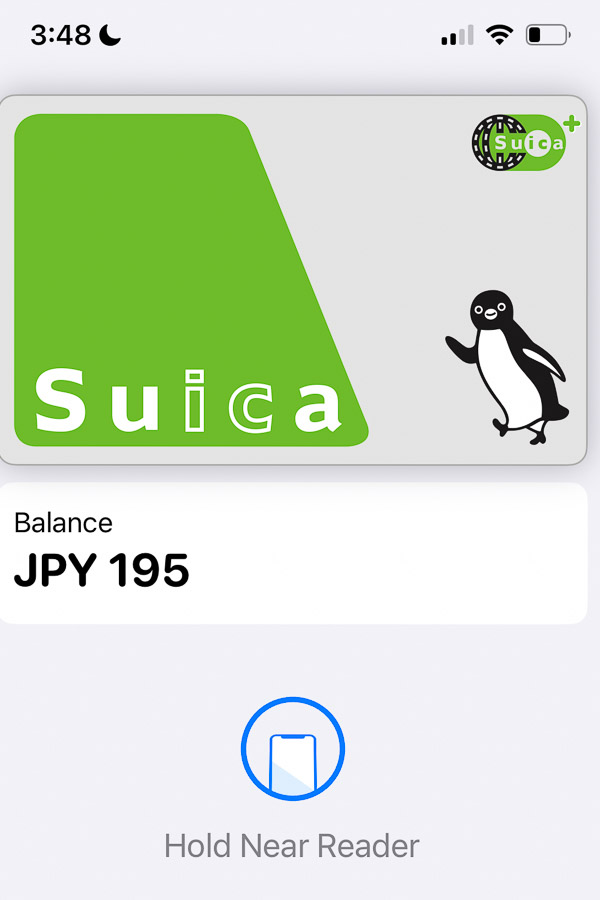
Even if you have a Suica, the subway pass can still be good value if you are making lots of trips on the subway in a certain period. Travel conveniently around Tokyo through Tokyo Metro and Toei Subway lines for 1-3 days with this Unlimited Pass.
While I recommend using the subway to get around Tokyo, if you’d prefer to keep things simple, Hop-On Hop-Off buses are plentiful around the main attractions in Tokyo.
Where to Stay in Tokyo
Generally, I recommend staying in or near Shinjuku (west side of Tokyo), or in the central area of Tokyo Station. However, as long as you are within walking distance of one or two subway stations/lines you will be fine!
I’ve suggested a few accommodation options below for different budgets in these areas.
Accommodation in or near Shinjuku (West Tokyo):
- Budget – Kimi Ryokan: I almost don’t want to share this in case it gets too popular, but Kimi Ryokan in Ikebukuro is my go-to budget accommodation in Tokyo. With traditional tatami mat bedding, this guesthouse is extremely clean, has shared bathrooms and lovely common areas.
- Mid-Range – Hotel Sunroute Plaza Shinjuku: You can’t beat the location of this centrally located hotel a short walk from Shinjuku Station. I prefer this hotel to similar-priced hotels in the busier Kabukicho nightlife area.
- Luxury – Park Hyatt Tokyo: We had a splurge night here to celebrate my husband’s birthday – the hotel’s New York Grill and Bar on the 52nd floor was featured in the movie Lost in Translation
Accommodation in or near Central Tokyo:
- Budget – the b ochanomizu: We stayed in this basic but clean hotel in Kanda, which was within walking distance to Akihabara and close to the subway. The rooms are small but modern and functional.
- Mid-Range – Via Inn Prime Nihonbashi Ningyocho: I was pleasantly surprised by the size of the rooms in this new, modern hotel. The location was within walking distance of two different subway lines.
- Luxury – The Gate Hotel: This trendy hotel is in the heart of Ginza, within walking distance to Tokyo Station and the Imperial Palace.
Explore all accommodation options in Tokyo
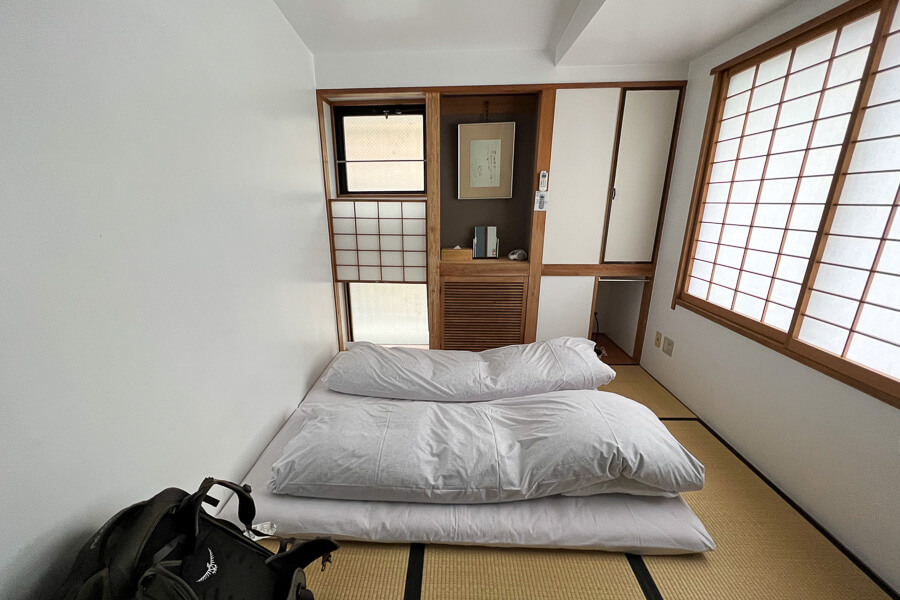
Tokyo Itinerary 7 Days
One Week in Tokyo Itinerary Map
Day 1: Harajuku and Shibuya
Welcome to Tokyo! Begin your Tokyo 7 Day itinerary by immersing yourself in the vibrant, colourful and quirky streets of the Harajuku district.
Harajuku
Conveniently located on the Yamanote line, when you get off the subway at Harajuku Station you’ll find yourself at the top of the main street of Harajuku, Takeshita Street.
This bustling street is lined with hip fashion boutiques, crepe stands, food shops, themed cafes and more. You’ll likely see young people dressed in quirky and unique street fashion, including some very kawaii (cute) outfits or punk hip-hop styles.
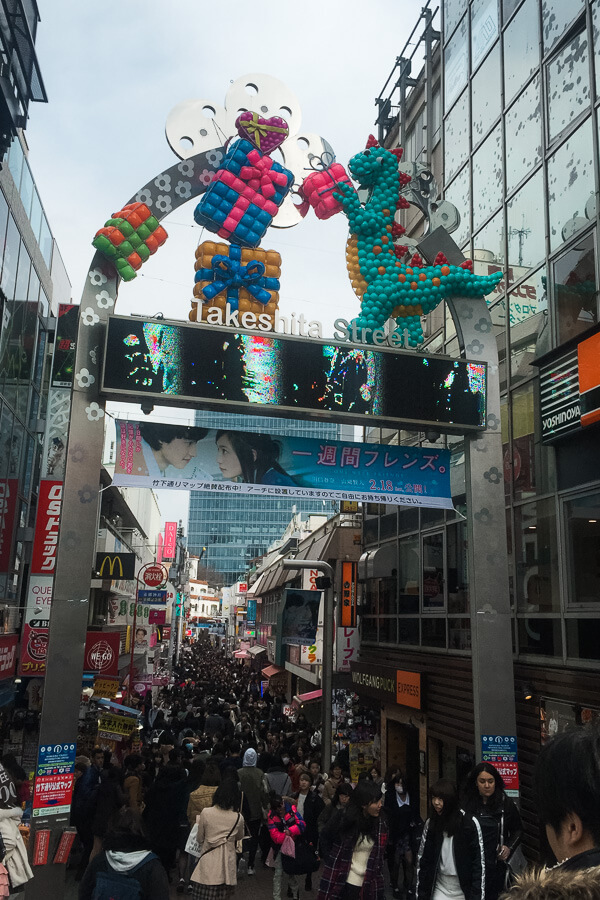
It can be overwhelming, particularly if you visit on the weekend!
My recommendation is to walk down Takeshita Street first before it gets too crowded, and then head to the quieter Omotesando Hills area. The Omotesando Hills consists of manicured streets with trendy boutiques and hip cafes, and is likened to the “Beverley Hills of Tokyo.”
Walk to Tokyu Plaza Omotesando, and make sure to check out the mirror entrance for a cool photo spot! You’ll also pass by Kinji Used Clothing, a massive second-hand clothing store that is a favourite of mine for high-quality, affordable used clothing.
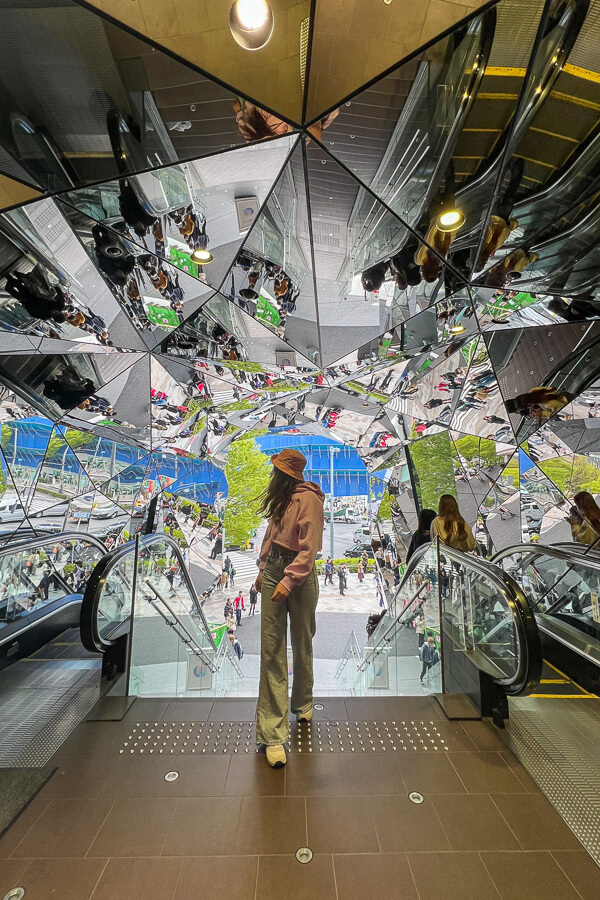
Continue exploring the trendy shopping streets – Cat Street is relatively quiet when compared to Takeshita Street, and you’ll find many trendy clothing stores and cute cafes.
If you need a snack stop or lunch, around the corner you’ll find Harajuku Gyozaro, a popular restaurant that specialises in dumplings. You’ll often see a line out the front (not an uncommon sight in Japan), but it moves quickly and is worth it!
Cross over the Jingumae Pedestrian Bridge.
In these picturesque streets, you’ll find Koffee Mameya, a cult specialty coffee store as well as the popular Tonkatsu Maisen Aoyama – one of the best-regarded tonkatsu (breaded pork cutlet) restaurants in the city.
We once got here before it opened for the chance to try their “Tokyo X” black pig pork katsu which is so exclusive it is only served to 5 customers a day! While it was delicious, I’m not sure we noticed enough of a difference to be worth the extra price.
If you need a coffee stop, another of our favourites in the area is Streamer Coffee Company. They have two coffee locations, but the one north of Omotesando is unique in its design with its multi-storied, narrow building made out of shipping containers.
Meiji Jingu Shrine
Cross the train line and meander towards the Meiji Jingu Shrine.
Open every day of the year, entrance to Meiji Jingu is free. You’ll pass the wall of sake barrels before passing under a large torii gate and entering the shrine. Nestled amongst nature, a visit to this 100-year-old shrine is a peaceful and tranquil experience compared to the hustle and bustle of the streets of Harajuku.
Open: Daily (times vary, check here)
Entrance: Free
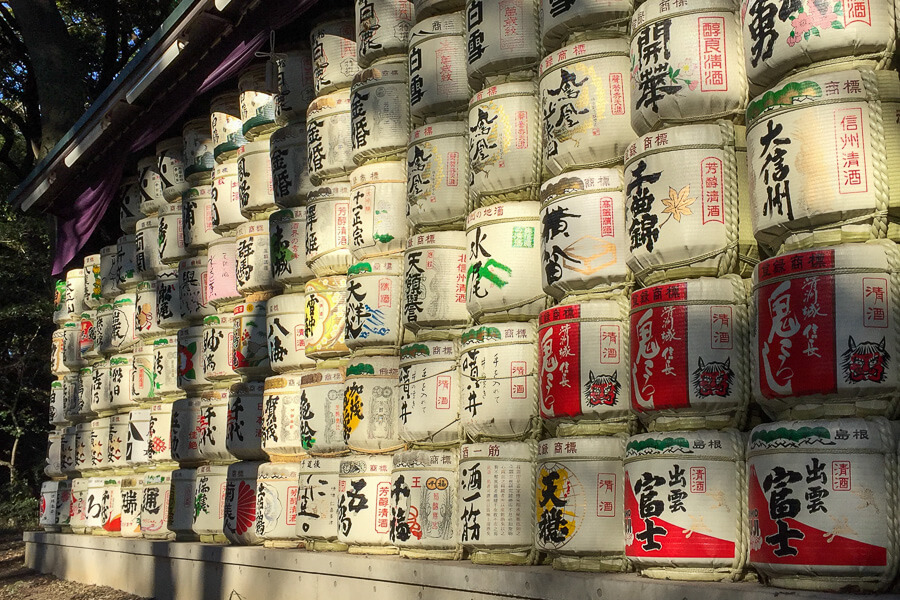
Shibuya
Walk or catch the subway one stop to Shibuya Station, spending the rest of your afternoon and evening exploring this iconic hub of Tokyo.
Near the station, make sure to stop by the Hachiko statue, the heartwarming memorial of the loyal dog who waited for his owner by the station each day – even after his death. These days, it’s used as a meeting point for groups of friends before exploring or dining in Shibuya.
Right next to the station and the Hachiko statue is the world-famous Shibuya Scramble Crossing, which is considered the world’s busiest pedestrian crossing – an estimated over 2.4 million people cross Shibuya every day! An estimated 2,500 – 3,000 people are crossing this particular spot at a time.
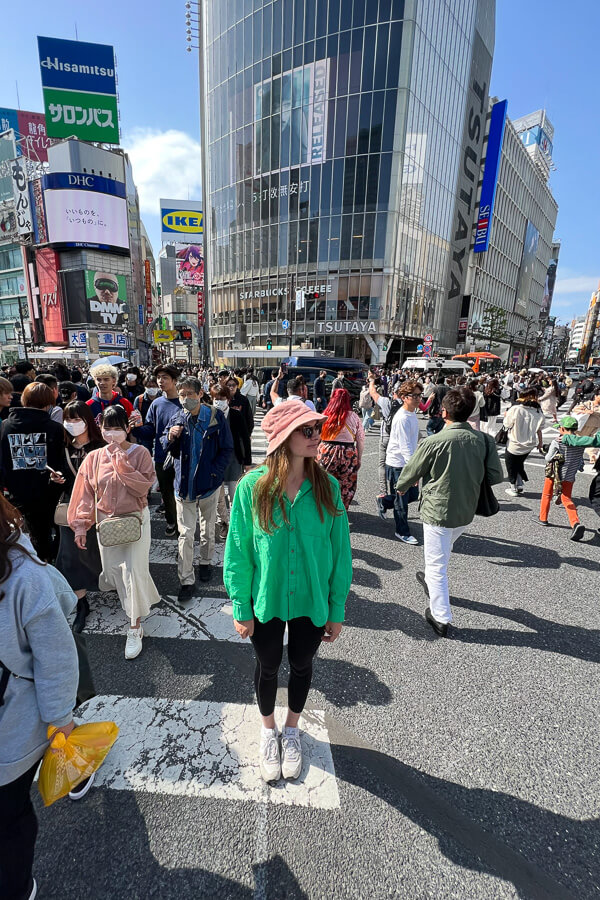
The crossing is best viewed from above – on our first visit, we headed to the Starbucks across the road and sipped on lattes while watching the thousands cross below.
On our most recent visit, we bought tickets to the new Shibuya Sky attraction. This popular spot offers insane 360-degree views of Shibuya and the endless sprawl metropolitan sprawl of Tokyo from an open-air observation deck on the rooftop of the Shibuya Scramble Square (47 floors high!).
Tickets are available 4 weeks in advance, and sunset sessions book out very quickly. So make sure to book your ticket ahead of time here.
Open: Daily 10am – 10.30pm
Entrance: ¥2200 – purchase online tickets easily with Klook (bookings available 4 weeks in advance)
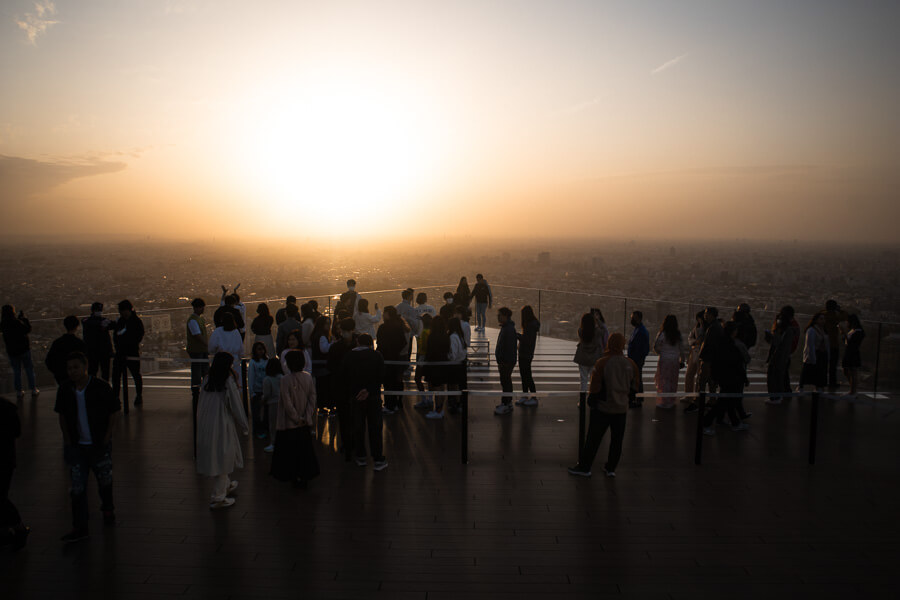
For food, we wandered the Dogenzaka-dori and found a small izakaya in a basement. You’ll find lots of spots like this, or head to the ever-popular Ichiran ramen restaurant chain for a must-try bowl of noodles.
For a local perspective, explore Shibuya with a local guide – you’ll visit some lesser-known spots while learning about the history, sights and local recommendations from your guide.
Day 2: Gotokuji Temple, Shimokitazawa and Shinjuku
Gotokuji Temple
Start your second day in Tokyo by catching the Odakyu Line to Gotokuji Station. From here, it is a 15-minute walk through the local neighbourhood to Gotokuji Temple, otherwise known as the Lucky Cat Shrine.
Open: Daily 6am-5pm
Entrance: Free
This Buddhist temple doesn’t appear to be anything unique until you get to a small section in the back corner which is filled with hundreds (if not thousands) of Maneki Neko lucky cat figurines. As cat lovers and big Japanese culture fans, this was a must-visit attraction for us!
This is definitely an underrated and lesser touristed attraction in Tokyo, we loved walking through the temple grounds, admiring all the maneki neko statues and taking photos around the temple and grounds.
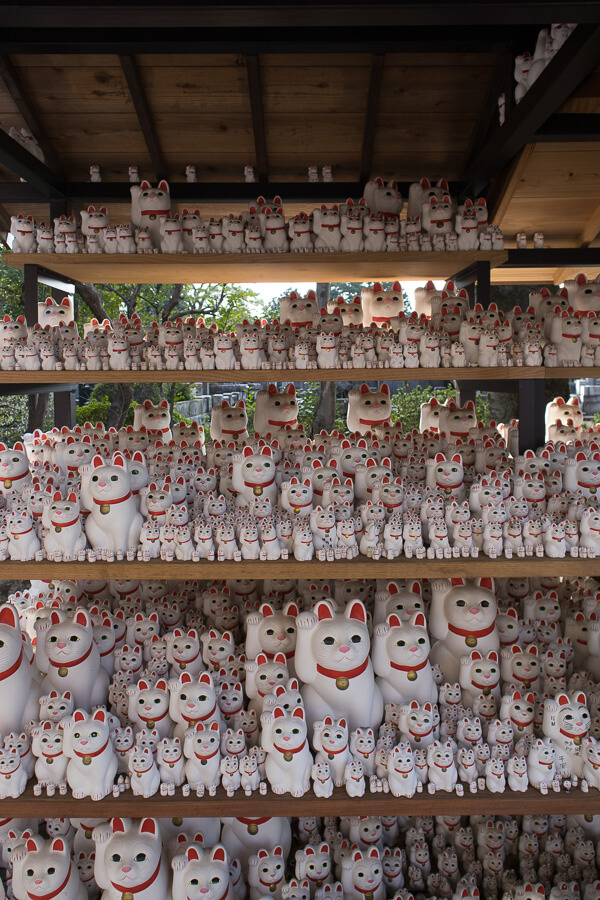
Shimokitazawa
After a visit to the Gotokuji Temple, it was easy to jump back on the Odakyu Line at Gotokuji Station and travel one stop to Shimo-Kitazawa Station.
Shimokitazawa is a trendy neighbourhood best known for its large range of vintage and second-hand clothing boutiques. The stores are generally more upmarket and include vintage designer items and one-of-a-kind items.
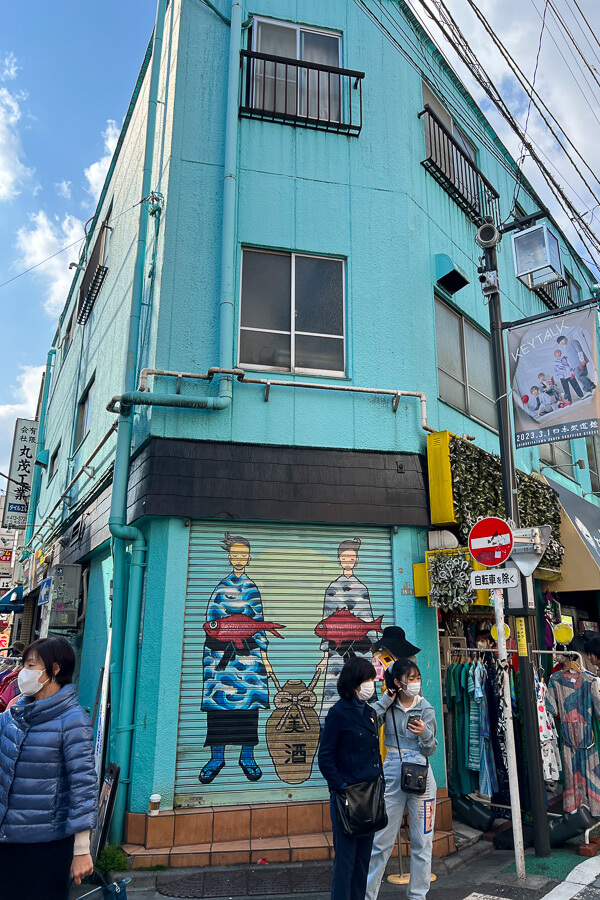
There are also many cosy, hip cafes, and many specialty coffee stores (perfect for the coffee-lovers like us!). We enjoyed a unique coffee experience at the trendy, minimalistic-designed Ogawa Coffee Laboratory.
You choose your beans at the counter from a large list based on your flavour and roast preferences, before watching your coffee be prepared in front of you. We also tried their house specialty, square scones.
You’ll find the largest concentration of vintage stores in the area north of the station, whereas east of the station is more boutiques and quirky stores. You’ll find you can easily spend a few hours wandering the streets and browsing the boutiques.
Shinjuku
Spend the rest of your afternoon and evening exploring the bright lights of Shinjuku.
If you need a break from the fast-paced city vibes, Shinjuku Gyoen National Garden is stunning, especially when we visited during cherry blossom season.
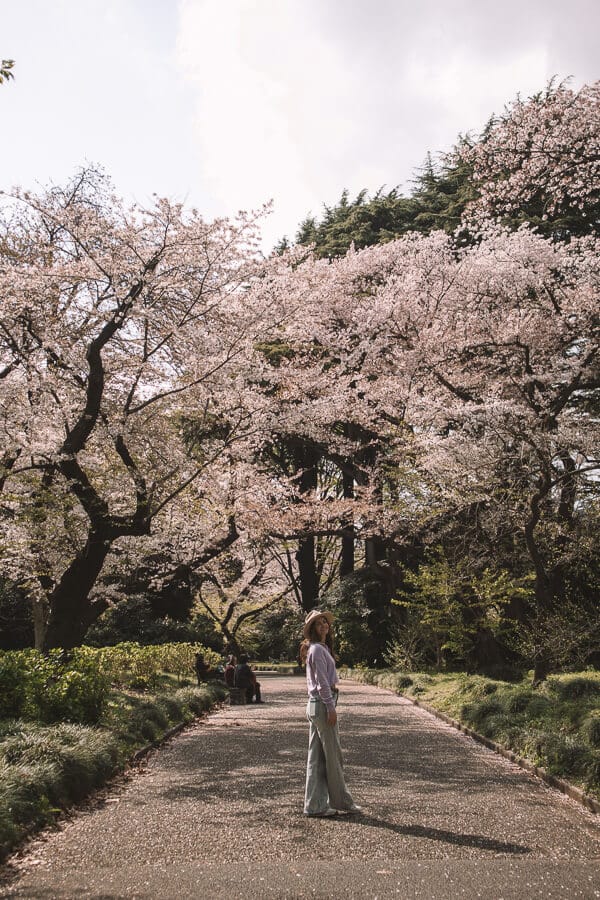
With over 144-acres of expansive grassed areas, serene lakes, tranquil greenhouses and landscaped Japanese gardens. Great to visit in spring (cherry blossoms) or autumn (autumn colours).
Open: Daily except for Mondays. Special opening times apply in April and November
Entrance: ¥500
Shinjuku is another shopping haven – we went to our first Don Quijote here in Shinjuku.
Don Quijote is an overwhelming and somewhat chaotic shopping experience, but also a haven for tourists wanting to get unique Japanese snacks, gifts or nick-nacks. I also love the affordable Japanese skincare here!
If you need a coffee break and rest stop, the pudding at All Seasons Coffee blew our mind!
My favourite things to do in Shinjuku at night include eating, drinking and visiting the massive game arcades. A favourite dinner spot for tourists and locals alike is the Standing Sushi Bar to the west of Shinjuku at Uogashi Nihon-ichi. We come here every time we visit Tokyo and it never disappoints!
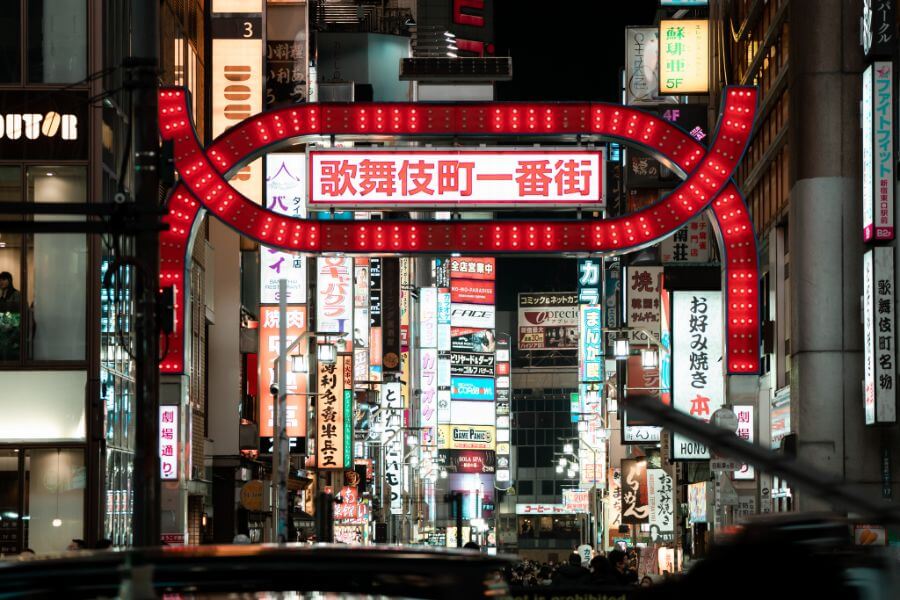
You’ll find a large SEGA game arcade around the corner, making it a great spot for some after-dinner entertainment.
On our most recent Tokyo trip in 2023, I discovered an amazing sake bar in Shinjuku hidden away on the upper floor of a nondescript building. We learnt so much about the different styles of sake at Yata Yata while taking in the bright lights of Shinjuku for the window on the 10th floor – highly recommend!
Shinjuku is also home to a few sake markets. At these popular bars, you pay a fixed price for all-you-can-drink sake that you serve yourself. You can buy a few snacks from the bar, or bring your own food from the local convenience store. This is our favourite way to try new and different sake styles!
Reserve your sake market experience in advance here.
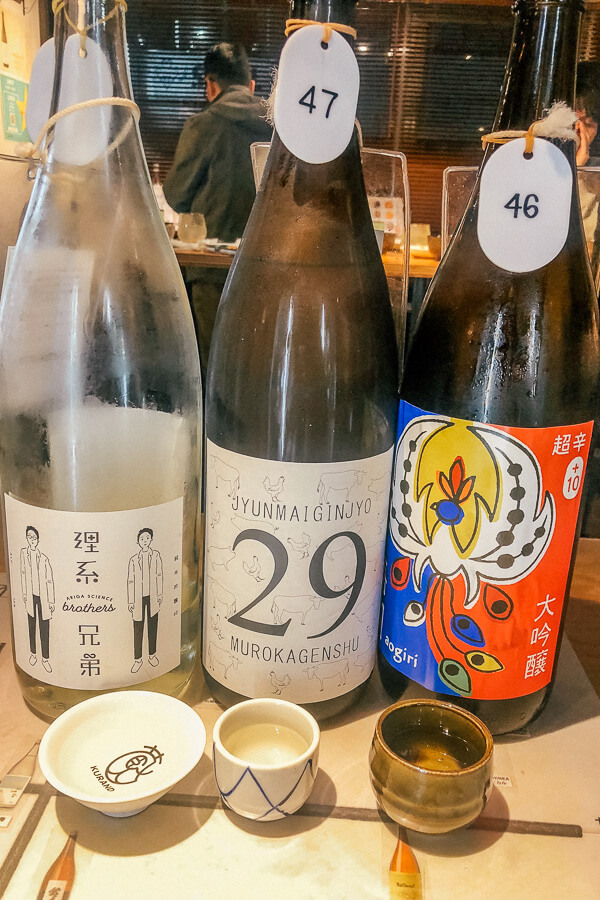
It’s also worth strolling the Kabukicho red-light district – you’ll know you are in the right place when you see the giant Godzilla head peeking over the top of Toho Cinema and Hotel Gracery!
We came here on our very first visit to Japan in 2013 to visit the famous Robot Restaurant, which unfortunately closed during COVID.
Nearby you’ll discover the Shinjuku Golden Gai, a maze-like area of small alleyways with little bars and local izakayas scattered around.
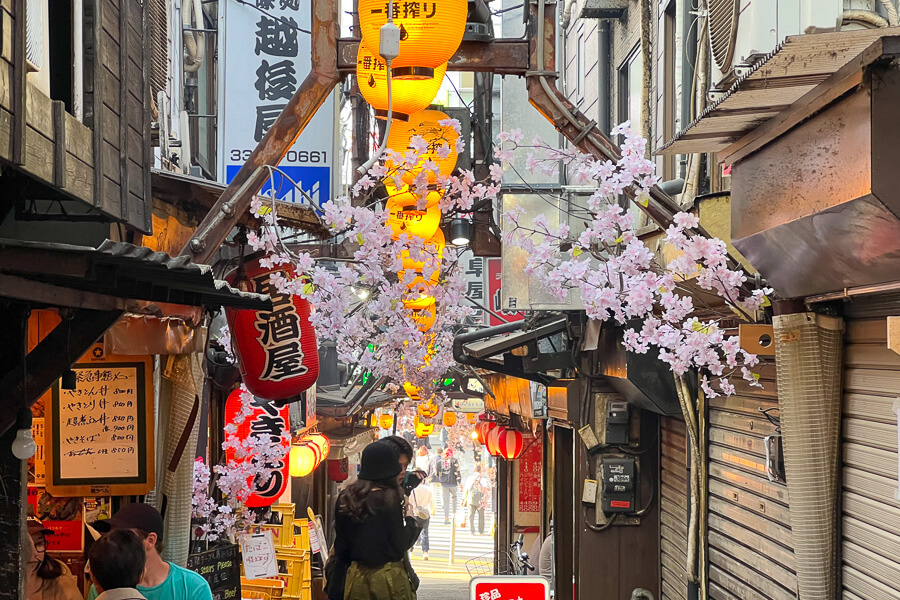
Another popular izakaya street is found near the train tracks at Omoide Yokocho – or Piss Alley as it is affectionately known! This small alleyway comprises local eateries where you sit shoulder to shoulder with Japanese businessmen, eating grilled skewers of meat and drinking beer.
Lastly, don’t miss the famous Shinjuku 3D cat billboard! I stood here for at least 15 minutes watching the lifelike animated cat on the giant billboard above. You’ll find it around the corner from Omoide Yokocho here.
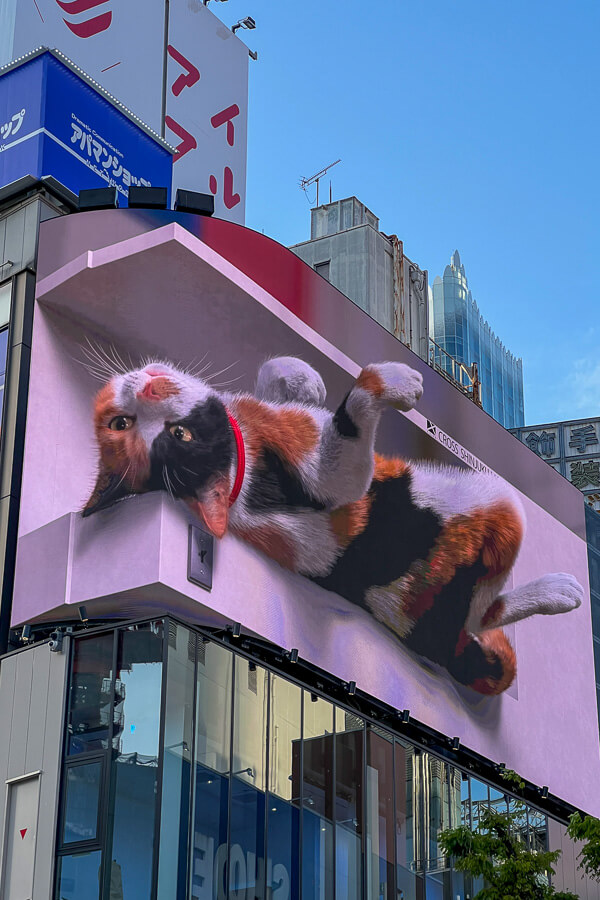
Day 3: Asakusa & Akihabara
Asakusa, Senso-ji and Tokyo Skytree
In the morning, make your way to the traditional Asakusa district and one of Tokyo’s most famous temples, Senso-ji. As one of the main tourist areas in Tokyo, this area gets busy! So it’s a good activity to do earlier in the day, although many of the shops won’t open until 10am.
You’ll begin by stepping through the large Kaminarimon lantern gate, marking the entrance to Senso-ji temple and leading into Nakamise Shopping Street.

This bustling street is lined with numerous souvenir shops, food stalls and other treats. Sample local food while browsing the different shops, but please note that in Japan it is considered rude to walk and eat (you might see signs asking you to stand outside the food vendors to eat in many food markets around the country).
Continuing along the street, you’ll soon reach Senso-ji – Tokyo’s oldest Buddhist temple.
Open: Daily 6am – 5pm
Entrance: Free
Explore Asakusa on an informative rickshaw tour. Pass temples and shrines, explore quirky neighbourhoods, venture through Sumida Park and traverse historic streets with a local guide.
If you’re interested in visiting a cat cafe, near Senso-ji you’ll find a great ethical option at Cat Cafe Asakusa Neko-en. Here, the cats are all rescues and available for adoption.
Please re-consider visiting any other animal cafes, particularly exotic animal cafes such as owl cafes or hedgehog cafes – these aren’t ethical or sustainable places.
After exploring the temple grounds, you can head to the Tokyo Skytree. Until the opening of Shibuya Sky, Tokyo Skytree was the most popular observation deck in Tokyo!
Standing at 634 metres tall, it is Tokyo and Japan’s tallest tower! It has the highest observation decks in Japan – the lower deck (Tembo Deck, 350 metres) and upper deck (Tembo Galleria, 450 metres). Unlike Shibuya Sky, both decks are enclosed and protected from inclement weather.
It is recommended to buy tickets in advance, to avoid long queues for tickets (particularly on weekends).You can buy a ticket just for the lower Tembo Deck, or a combined ticket for both the Tembo Deck and Tembo Galleria. Prices are cheaper for tickets bought before the day of visit. You can check prices and book here.
Open: Daily (opening times vary, usually from 10am – 9pm but check first)
Entrance: Varies based on ticket type – official prices start from ¥1800 but you can usually get cheaper tickets during non-peak periods by booking in advance with Klook.
Akihabara
Akihabara is one of my favourite places in Tokyo. The minute I step out of the train station and onto the vibrant streets, surrounded by flashing neon billboards on every possible building surface, I always get the biggest buzz.
Akihabara Electric Town, or “Aki” as it is affectionately called, is famous for its electronic shops and pop culture fans. Here you will find all kinds of electronics and gadgets, Japanese pop culture anime including anime, manga, video games and toys, maid cafes and other themed restaurants as well as many video arcades and game centres.
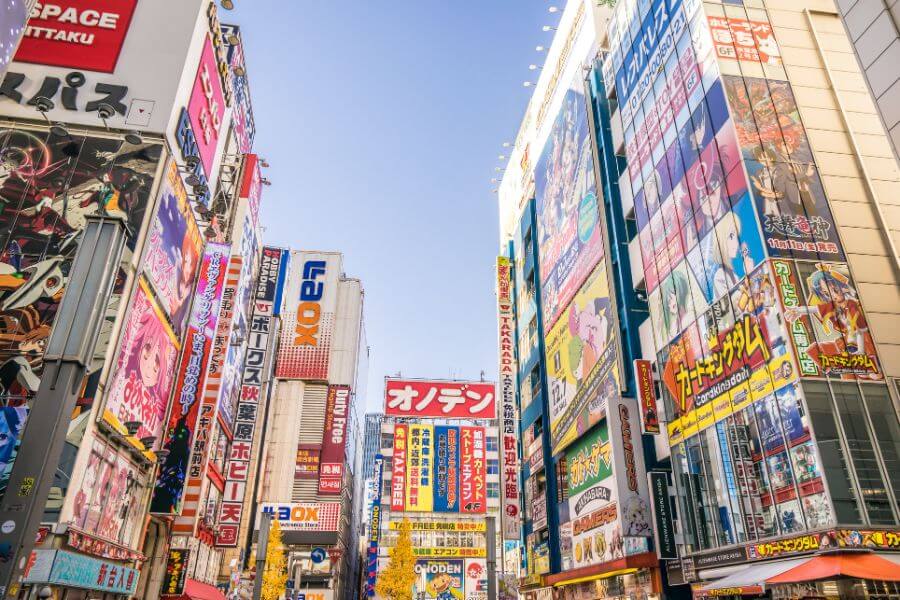
Spend most of your time here exploring the many, many stores. Some of my favourites include Mandarake, Super Potato and Book Off. Akihabara is also the place in Tokyo to visit a cosplay maid cafe. You can pre-book this experience here.
For a fun activity, zoom around the streets of Akihabara on this go-kart tour. 1 or 2-hour experiences are available, and you’ll need to bring an International driver’s licence.
Get more information on this highly-rated memorable experience.
For lunch, we decided to try the Akihabara location of Gyukatsu Motomura. This bustling restaurant was one of my favourites on our most recent trip. The concept here is beef katsu, but you cook it yourself on a stone plate to your liking. It comes as a set meal with rice, miso soup, cabbage and a few sauces, and it was the tastiest katsu I’ve EVER had!
We had to line up for nearly 30 minutes even at 2pm, but it was SO worth it!
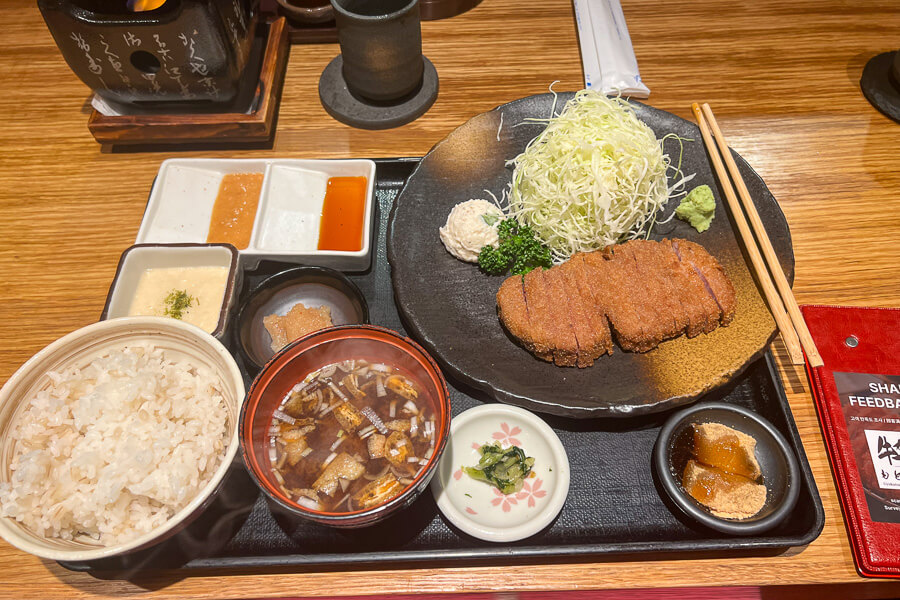
If you are looking for a nearby dinner spot, we had a great local izakaya experience at Darumasakaba in Kanda.
We were the only foreigners in this downstairs restaurant packed with locals, but the friendly owner found us a seat at the bar, and with his help and Google translate we worked our way through the menu in Japanese. One of those nights that was an experience we won’t forget anytime soon!
Bonus: Nezu Shrine
If you have daylight time remaining, a short train ride away will take you to Nezu Shrine. This is one of Tokyo’s underrated gems, off the beaten path for the majority of tourists when we last visited.
At Nezu shrine, you can wander through numerous orange torii gates leading to a small, tranquil shrine, reminiscent of the popular Fushimi Inari in Kyoto.
Open: Daily 5am – 6pm
Entrance: Free
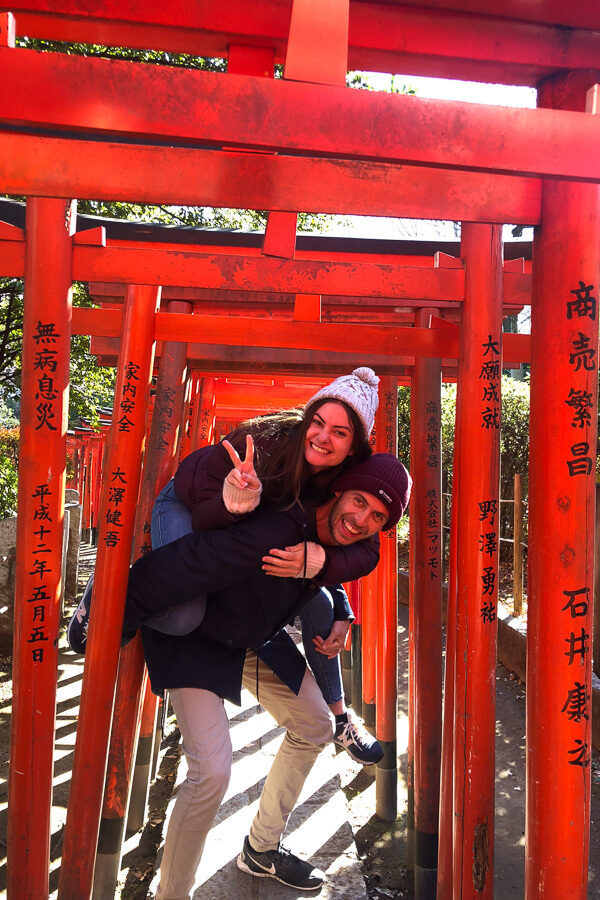
Day 4: Tsukiji Market, TeamLab Planets & Ginza
Tsukiji Market
A quintessential Tokyo experience I highly recommend is passing up on a hotel breakfast one morning in favour of a fresh sushi breakfast instead at Tsukiji Outer Market.
Tsukiji, the biggest fish market in the world, moved its wholesale operations to the new Toyosu Market in 2018. However, the iconic Tsukiji Outer Market, consisting of restaurants and small market stalls, remains in its original location in the Chuo City district.
Here you can sample some of the freshest sushi and seafood in the world for breakfast.
On my most recent visit in April 2023, we enjoyed fresh tuna and salmon donburi (rice bowl) at Tsukiji Donburi Ichiba. This tiny shop has counter seating for just 5 customers at a time, making it an intimate affair.
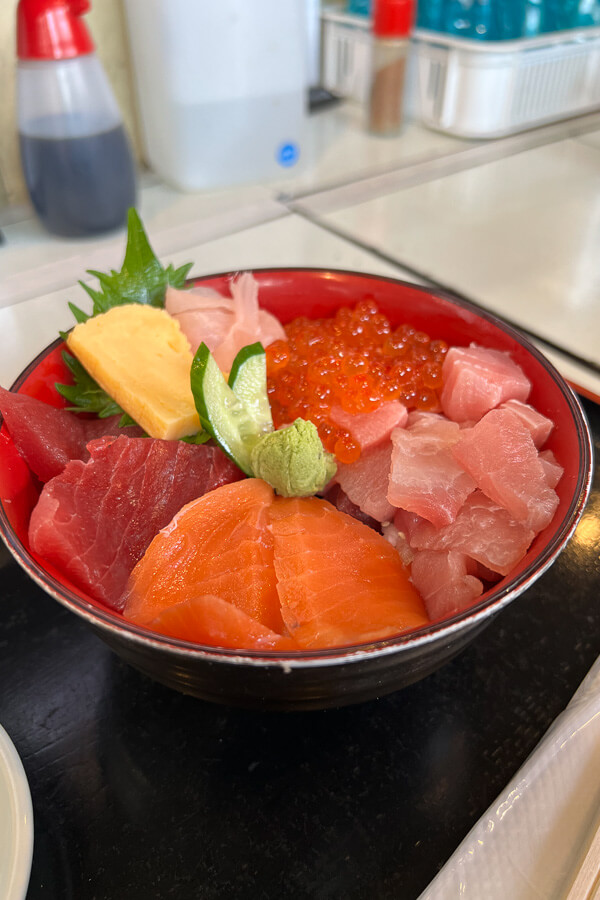
Popular sushi restaurants at Tsukiji Markets include Tsumugi, Tsukijiro, Motodane and Sushizanmai (a chain store across Tokyo, but this is their Main Branch). You’re also guaranteed to find a perpetual queue lining up outside Sushi Dai.
You can also try a variety of snacks from the various market stalls – we tried tomago (egg) on a stick, grilled unagi (eel), delightful strawberry mochi and my all-time favourite, delicious taiyaki (steaming hot custard-filled pastries in the shape of a fish) served by a lovely old lady at Tsukiji Sanokiya.
I’m drooling just thinking about those taiyaki – they were the best we had during our one month trip to Japan!
Wander the markets at your own pace, or join a local guide on a food tour.
TeamLab Planets
After eating way too many delicious things, we caught the bus a short ride down the road to TeamLab Planets. This was my second visit to a TeamLab exhibition, after visiting TeamLab Borderless a few years ago.
The TeamLab interactive displays are truly mesmerising and a work of art, so it’s highly worth visiting one of their displays.
At the time of writing in November 2023, TeamLab have exhibitions in Tokyo at TeamLab Planets and in Osaka at TeamLab Botanical Garden. In February 2024, TeamLab Borderless is due to reopen at a new location in Azabudai Hills.
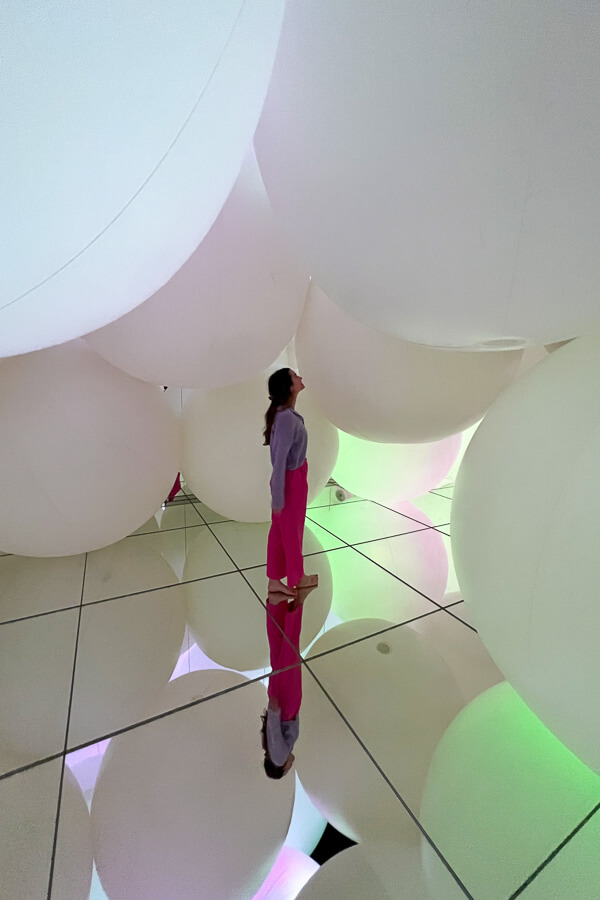
At TeamLab Planets, you walk through water, rooms full of sparkling floor-to-ceiling lights and giant colourful balls, and sit beneath a garden of flowers. It’s a surreal experience, and worth visiting at least one of the TeamLab exhibitions while in Japan.
You will need to book a specific time slot for your visit, and tickets sell out in advance – so make sure to book at least a few weeks ahead! I found it easier to book with GetYourGuide, as it was easier to select time slots, however, Klook also has tickets for sale.
Open: Daily 9am – 10pm
Entrance: ¥3,800 – timed entry tickets need to be purchased in advance
Ginza
Make your way to the high-end, glamorous shopping district of Ginza.
Considered the mecca of luxury shopping in Tokyo, we spent most of our time wandering around the posh streets and admiring the lavish store displays. Make sure to walk past the Bulgari flagship store to see the glittering serpent wrapped around the building.
Other fun things to do in Ginza include visiting the Art Aquarium Museum (a museum of goldfish!), visit UNIQLO’s biggest flagship shop or watch a kabuki play and the Kabukiza Theatre.
After window browsing or shopping up a storm, you can try Michelin Bib Gourmand rated tempura at Tempura Abe Honten – but be prepared to queue! Another recommended spot is Ginza Hanadaikon, which serves delicious wagyu beef.
Day 5: Hie Shrine, Imperial Palace, Tokyo Station & Ikebukuro
Hie Shrine
Start your day with a morning visit to Hie Shrine, another spot in Tokyo with the famed orange torii gates.
The entrance to Hie Shrine is impressive, with a large torii gate standing tall before the long flight of steps leading to the top of the hill. Here you will find the Hie-jinja shrine, a guardian shrine of the Imperial Palace (which you’ll also be visiting later today).
On the western entrance, you’ll find a tunnel of torii gates lining the steps leading to the back of the temple.
Open: Daily 6am – 5pm
Entrance: Free
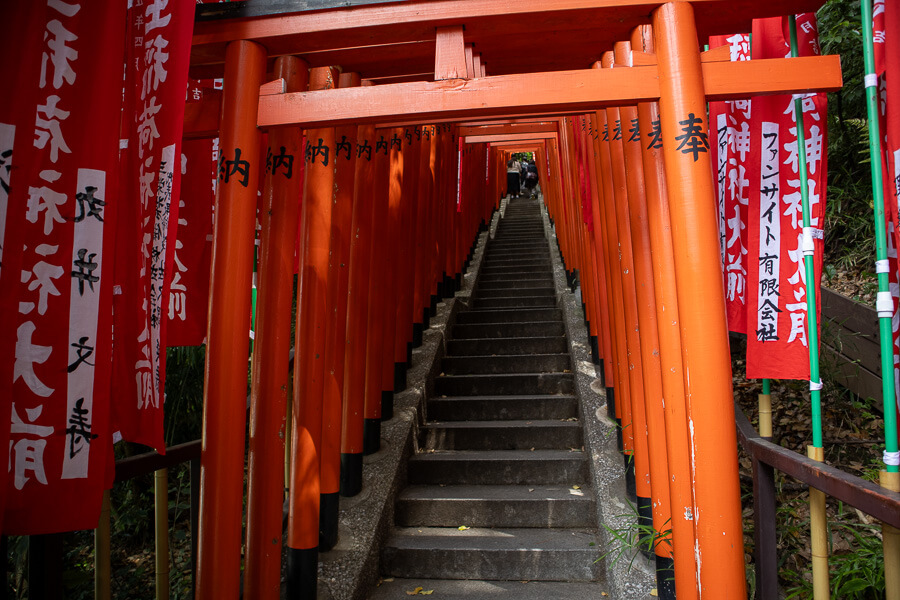
Imperial Palace Gardens
Hop on the Chiyoda line at nearby Kokkai-gijidomae Station and travel 3 stops to Nijubashimae Station. You’ll surface at the entrance of the Kokyo Gaien National Garden plaza and views of the Imperial Palace.
Located on the site of the former Edo Castle, the Imperial Palace is home to the Emperor of Japan. The palace is surrounded by impressive gardens, massive moats and towering stone walls.
The inner grounds and palace are closed to tourists, but you can explore the expansive and picturesque East Gardens for free most days of the week.
Open: Generally 9am-5pm but varies seasonally. Closed Mondays and Fridays. Check official opening times and dates here
Entrance: Free
Tokyo Station
The next attraction on your Tokyo itinerary for today is the massive Tokyo Station. Much more than just a train station, Tokyo Station is a historic landmark and bustling hub of shops, restaurants and more.
Walk from the East Gardens to the Marunouchi Square entrance of the station. Admire the classical red-brick facade that has been carefully restored to its original state, standing out from its neighbours of modern skyscrapers.

Head underground and explore the maze-like streets below the station. Tokyo Station has unique themed sections. Make sure to visit Character Street, with shops selling Japanese anime goods, including a small Pokemon store.
Grab lunch from one of the many restaurants on Ramen Street, where you can find all kinds of ramen styles from across Japan.
Ikebukuro
Spend the rest of your day exploring Ikebukuro, which I best describe as a smaller but still vibrant version of Shinjuku. On our last two trips to Tokyo, we stayed in Ikebukuro at one of our favourite budget accommodations in Tokyo, Kimi Ryokan.
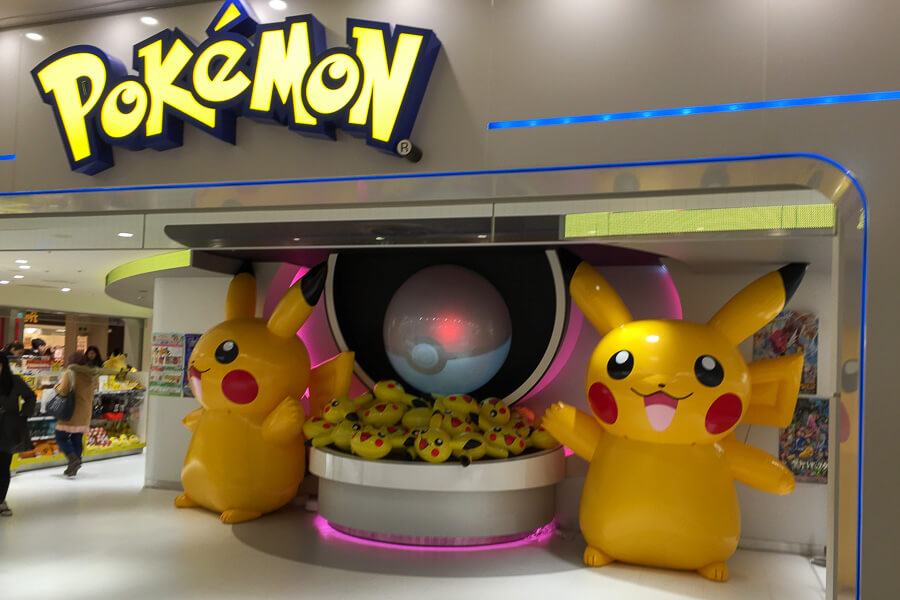
In Ikebukuro, you’ll find many electronic stores and department stores, some great coffee shops (like Mermaid Coffee Roasters) and brilliant ramen restaurants (hello, Kikanbos).
Head to Sunshine City Mall, home of the mega Pokemon Center, and the world’s largest gashapon (gacha gacha) capsule toy store at Gashapon Ikebukuro.
Day 6: Experience the Magic of Disneyland or DisneySea
Get ready for a magical day at Tokyo Disneyland! This was the first Disney theme park outside of the United States when it opened in 1983. Today, Tokyo Disneyland has seven different themed worlds.
Tokyo Disneyland is easily accessed through public transport. Get off at JR Maihama Station on the JR Keiyo/Musashino Line and jump on the Disney-themed monorail to arrive at Tokyo Disneyland Station.
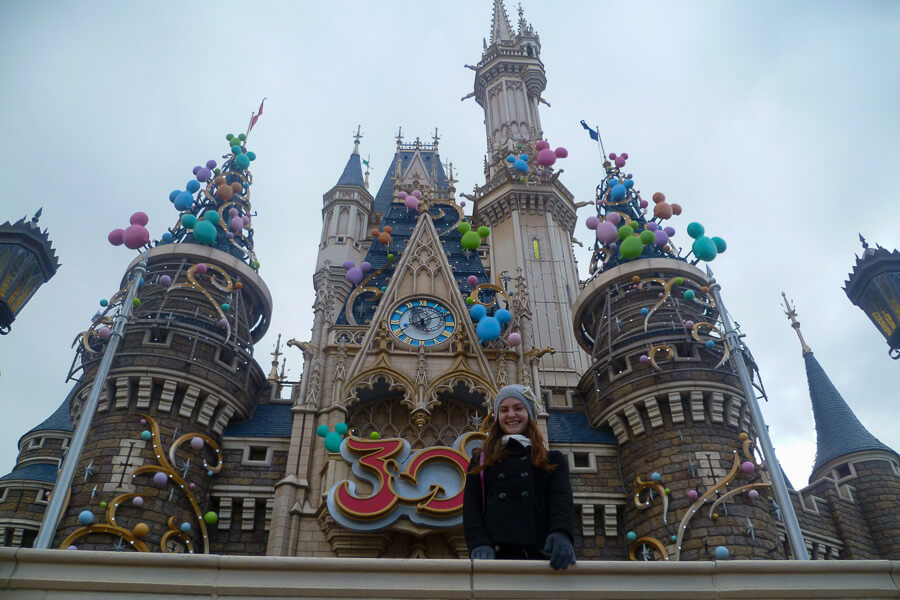
Tokyo is also home to the only DisneySea in the world!! On our second visit to Tokyo, we chose to spend the day at DisneySea after doing Disneyland on our first trip. DisneySea was spectacular, and many argue that its rides are better than Disneyland
I think if you haven’t been to Disneyland anywhere else before, you should stick with Disneyland Tokyo, otherwise seriously consider visiting DisneySea while in Tokyo as it is arguably the better theme park, and you can’t visit one anywhere else in the world!
Open: Daily, usually from 8am to 10pm
Entrance: From ¥8,900
Day 7: Day Trip to Mount Fuji
There are some incredible day trips from Tokyo that you should consider adding to your 7 days in Tokyo itinerary.
Hakone
Hakone is a picturesque hot spring town that is a lovely day or overnight trip from Tokyo. It’s worth spending a night at a traditional ryokan if your schedule and budget permits, otherwise a day trip is a great way to soak in the incredible scenery and unique attractions in this mountainous area.
I visited Hakone on my very first trip to Japan in 2013. It is possible to do a self-guided tour of Hakone using the Hakone Freepass. We followed the popular Hakone Round Course itinerary which takes you through a loop of Hakone’s main attractions using a range of different modes of transport.
We caught the Hakone Ropeway where we crossed over the Owakudani Valley, famous for its volcanic activity and sulphur vents. You can even get views of Mt Fuji on a clear day! From here, you jump on a scenic boat cruise across Lake Ashi, where you’ll spot the large red torii gate of the Hakone Shrine on the lake’s edge.
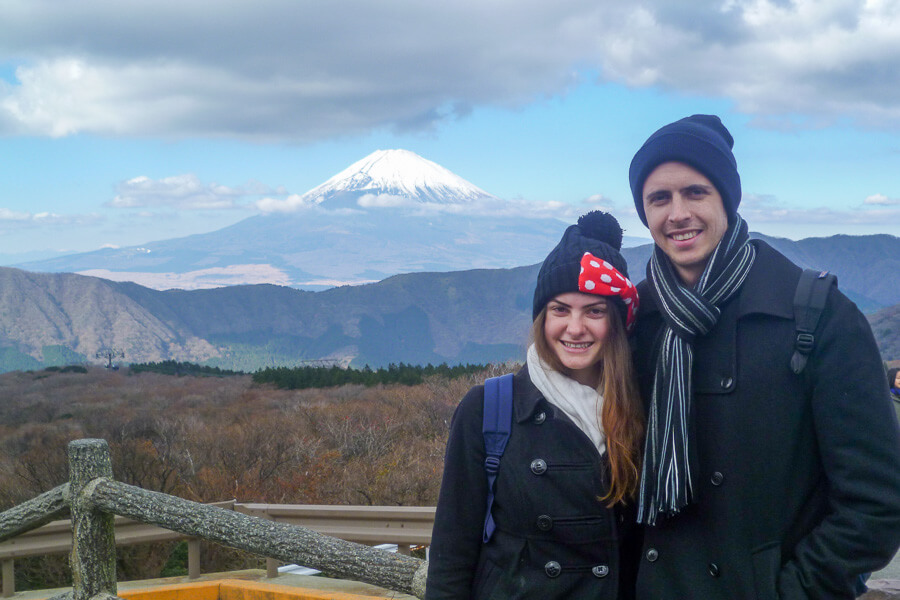
You can easily purchase a Hakone Freepass online which includes unlimited public transport (including the boat cruise across Lake Ashi). This 2-day pass is worthwhile even for a day trip if you are doing the full loop course in one day as a day trip from Tokyo.
If you prefer to join a guided tour with convenient bus transport included, consider this Hakone One Day Trip from Tokyo.
It includes a visit to the panoramic Mt Fuji Fifth Station, shopping at Gotemba Premium Outlets, riding the Hakone Ropeway, exploring the Owakudani Valley and a scenic cruise across Lake Ashi.
Lake Kawaguchi (Fuji Five Lakes area)
I recommend spending a few nights in Fuji Five Lakes if possible, otherwise to visit the best viewpoints of Mt Fuji, a day trip to Lake Kawaguchi is the way to go!
To visit Lake Kawaguchi on a day trip, joining an organised bus tour is the easiest and most convenient way to do so. Public transport in Lake Kawaguchi is limited and the main sights are spread across the town, making it hard to get to without your own transport in a day.
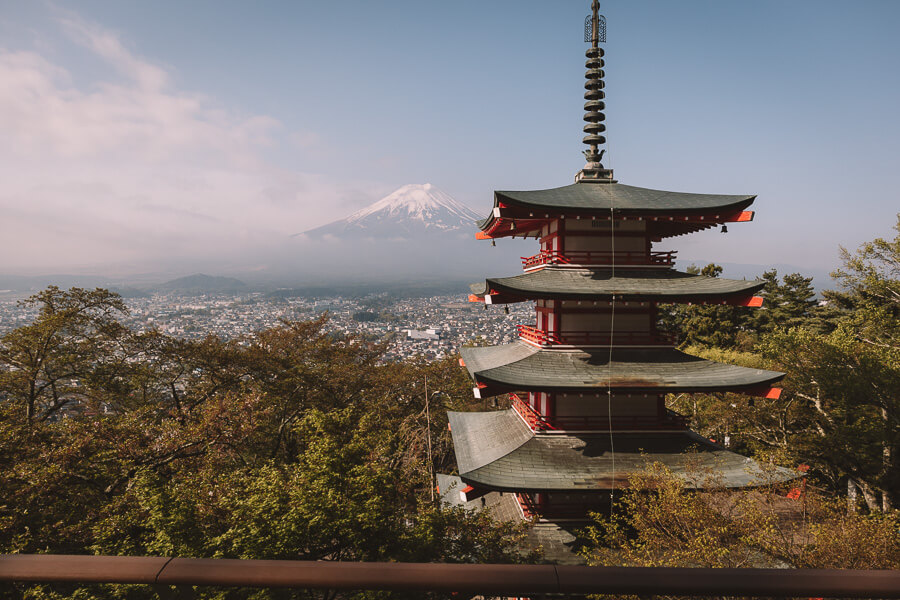
This tour takes you to the best Mt Fuji viewpoints in Kawaguchiko, including the beautiful Chureito Pagoda, Oishi Park and a visit to a traditional village on an easy and affordable day trip from Tokyo.
Another very popular Mt Fuji tour is the Mt Fuji Classic Route Day Tour.
This tour includes a stop at the Mt Fuji 5th Station, a visit to Oshino Hakkai, a series of pools thought to have been formed by erupting Mt Fuji and a shopping trip to Gotemba Premium Outlets, one of Japan’s largest outlets.
Final Thoughts – 7 Day Itinerary Tokyo
That wraps up this itinerary for Tokyo, 7 days of exploring the vibrant, cultural and quirky neighbourhoods that make up the sprawling metropolitan oasis that is uniquely Tokyo.
Whether it’s your first time exploring Tokyo, or even your fifth like me, this 7 days Tokyo itinerary will ensure there is never a dull moment!
If you have any questions about this 1 week in Tokyo itinerary, please feel free to include them in the comments below. Don’t forget to check out my other Japan guides to help plan your trip!
Plan your Japan adventures:
- 15 Things to Know Before Visiting Japan for the First Time
- 30 Unmissable Experiences for Your Japan Bucket List
- A Perfect 4 Weeks in Japan Itinerary: Ultimate Travel Guide
- How to Easily Visit the Chureito Pagoda from Tokyo
- An Exciting 4 Days in Osaka Itinerary for First-Timers
- 2 Days in Takayama: Discover Traditional Japan
- Koyasan Temple Stay: Essential Travel Guide & Tips
- Exploring Fuji Five Lakes: 3 Days in Kawaguchiko Guide
- 10 Most Mesmerising Views of Mt Fuji from Kawaguchuiko
- Cool Stuff to Buy in Japan: 20 Souvenirs Actually Worth Buying

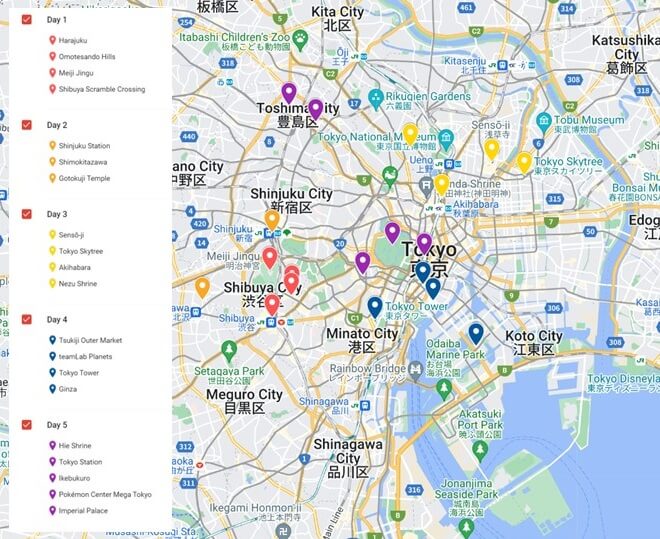
Hi, your post is very informative and I liked that you included some budget friendly options. We’re planning a 7 day trip to Tokyo in August for 3 people. I wanna ask how much is your recommended budget? Thanks in advance!
Hi Trixie! In April 2023, we averaged AUD $183 per person per day for our 4 weeks in Japan, including accommodation. You can see the detailed breakdown here: https://tessomewhere.com/4-weeks-in-japan-itinerary/#1_Month_in_Japan_Cost
If you are staying in Tokyo and not travelling to the cities, your cost might be a bit lower due not to catching the shinkansen. We tend to spend a lot on eating out too, and not as much on activities 🙂
Hi, your post is really helpful and very informative. I’m planning to visit Tokyo in December. I wanna ask if the itinerary will be the same like one you post here? Thanks in advance!
Thanks! Yes, you can follow a similar itinerary. December is a great time to visit, it will be very festive with lots of Christmas light displays and themed displays in shops etc 🙂 Just remember to check for public holidays etc when planning your itinerary (especially for visits to places like Disneyland etc as these will be even busier than normal)